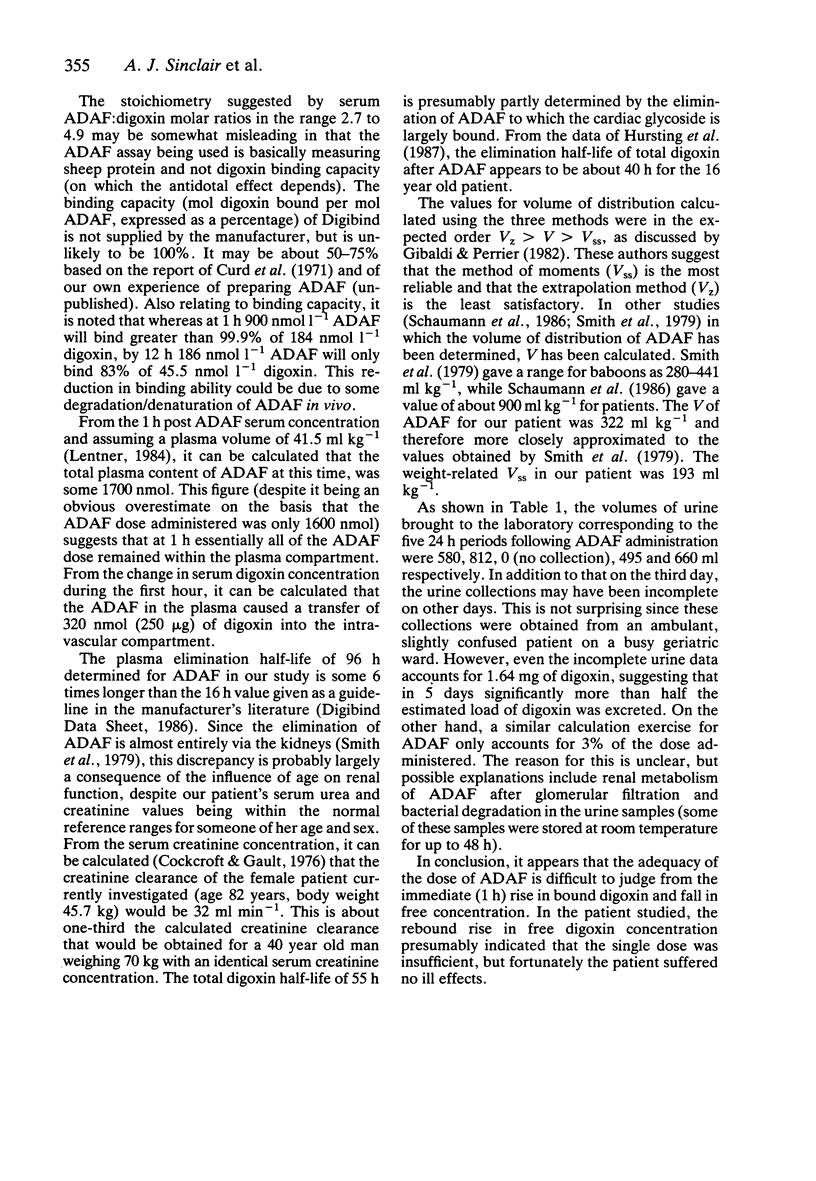Abstract
Anti-digoxin antibody fragments (ADAF, 80 mg) were infused intravenously to successfully treat severe digoxin toxicity in an 82 year old woman. During treatment, total and free digoxin were determined using an Abbot TDX analyser and an ultrafiltration technique. ADAF were measured by an enzyme-linked immunosorbent assay. By 1 h after ADAF, total serum digoxin concentrations had risen 12-fold from a pretreatment level of 15.4 nmol l-1 but free digoxin fell from 10 to 0.1 nmol l-1, indicating greater than 99.9% digoxin binding to ADAF. However, the low free levels had rebounded to 7.7 nmol l-1 by 12 h, but despite this rise the patient's condition had improved. A serum ADAF/digoxin molar ratio of around five was associated with the low concentration of free digoxin at 1 h, while at later times with ratios roughly between 3 and 4, the free digoxin concentrations ranged between 2.0 and 7.7 nmol l-1. ADAF were mainly confined to the plasma during the first hour, but subsequently distributed into an apparent volume of 193 ml kg-1. The elimination half-lives of ADAF and total digoxin were 96 and 55 h, respectively. More than 50% of the estimated digoxin load had been excreted in the urine by 5 days; for ADAF the equivalent figure was only about 3%. Renal and/or bacterial degradation may have contributed to the low detection of urinary ADAF.
Full text
PDF




Selected References
These references are in PubMed. This may not be the complete list of references from this article.
- Beerman L. B., Park S. C., Fischer D. R., Fricker F. J., Mathews R. A., Neches W. H., Lenox C. C., Zuberbuhler J. R. Ventricular septal defect associated with aneurysm of the membranous septum. J Am Coll Cardiol. 1985 Jan;5(1):118–123. doi: 10.1016/s0735-1097(85)80093-0. [DOI] [PubMed] [Google Scholar]
- Cockcroft D. W., Gault M. H. Prediction of creatinine clearance from serum creatinine. Nephron. 1976;16(1):31–41. doi: 10.1159/000180580. [DOI] [PubMed] [Google Scholar]
- Curd J., Smith T. W., Jaton J. C., Haber E. The isolation of digoxin-specific antibody and its use in reversing the effects of digoxin. Proc Natl Acad Sci U S A. 1971 Oct;68(10):2401–2406. doi: 10.1073/pnas.68.10.2401. [DOI] [PMC free article] [PubMed] [Google Scholar]
- Hursting M. J., Raisys V. A., Opheim K. E., Bell J. L., Trobaugh G. B., Smith T. W. Determination of free digoxin concentrations in serum for monitoring Fab treatment of digoxin overdose. Clin Chem. 1987 Sep;33(9):1652–1655. [PubMed] [Google Scholar]
- Johnston P. C., Stevenson I. H., Hewick D. S. The use of an enzyme-linked immunosorbent assay to study the disposition of sheep digoxin-specific immunoglobulin G and Fab fragments in the rat. Clin Exp Immunol. 1988 Dec;74(3):489–493. [PMC free article] [PubMed] [Google Scholar]
- Lemon M., Andrews D. J., Binks A. M., Georgiou G. A. Concentrations of free serum digoxin after treatment with antibody fragments. Br Med J (Clin Res Ed) 1987 Dec 12;295(6612):1520–1521. doi: 10.1136/bmj.295.6612.1520. [DOI] [PMC free article] [PubMed] [Google Scholar]
- Schaumann W., Kaufmann B., Neubert P., Smolarz A. Kinetics of the Fab fragments of digoxin antibodies and of bound digoxin in patients with severe digoxin intoxication. Eur J Clin Pharmacol. 1986;30(5):527–533. doi: 10.1007/BF00542410. [DOI] [PubMed] [Google Scholar]
- Smith T. W., Lloyd B. L., Spicer N., Haber E. Immunogenicity and kinetics of distribution and elimination of sheep digoxin-specific IgG and Fab fragments in the rabbit and baboon. Clin Exp Immunol. 1979 Jun;36(3):384–396. [PMC free article] [PubMed] [Google Scholar]


